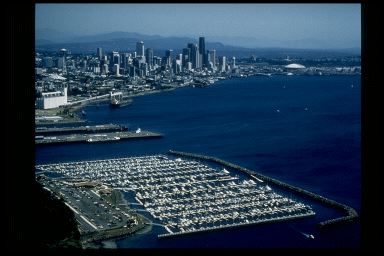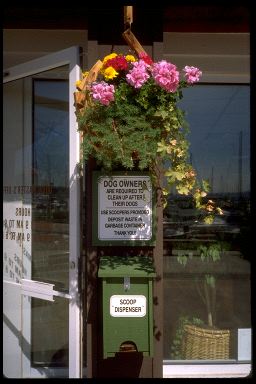
10. Elliott Bay Marina Inc.
Clean Environment Awards Win Customers
| Location: | 2601 West Marina Place, Seattle, Washington 98199 |
| Telephone: | (206) 285-4817, fax: (206) 282-0626 |
| Interviewed: | Martin Harder, General Manager |
| Owned by: | Three Seattle boaters and businessmen |
| Waterbody: | Elliot Bay, Puget Sound, Pacific Ocean |
Environmental change
Elliott Bay Marina was built to exceed environmental standards for habitat creation, pollution control, and water circulation, and it operates with effective clean marina practices for hazardous waste, spill prevention, dog waste, recycling, habitat testing, and educational programs.
The newest megamarina
Since it opened in 1991, after 12 hard years in the planning and permit process, Elliott Bay Marina has been recognized as a world-class facility that exceeds required environmental regulations. At a cost of almost $50 million, the private owners put many good things into this commercial marina. Ten full-time, year-round employees and 12 seasonal part-timers are kept busy managing 1,200 slips. The slips range in size from 32 to 63 feet with 52% of the boats between 36 and 50 feet LOA. The boat types are evenly split between sailboats and powerboats, which reflects the great sailing conditions on Puget Sound. Forty boats are liveaboards. Another 60 docks must remain available for transient boaters per agreement with the city.
Boat rentals are available, as are new and used boat sales. The Seattle Yacht Club has an outstation and clubhouse in this marina. Repair services available at Elliott Bay are for light maintenance only. Other services include a fuel dock, pumpout, laundry, and grocery store. Three restaurants in the marina illustrate the value added by being located with a water view in a busy marina. A time-sharing program is also available, similar to condo time-sharing.
While the marina operates year-round, the prime boating season is from April through October each year. Within a 2-mile radius there is one other marina, and between them the two marinas serve almost 4,000 boats.
"Providing first-class service to the boaters is as important as protecting the environment," Martin Harder said. "We try to meet every boat that comes in and help them with their lines. I was in the hotel business 30 years, so I try to run the marina like a hotel. Our mission is to beat the boater's expectations. To help do that I've hired a concierge to help our boaters any way possible." As a result, Elliott Bay Marina has a strong customer-service practice that reflects a profound change in the way marinas across America are going to be managed.
Management measures
Elliott Bay Marina complies with the marina management measures for habitat assessment, solid waste, and liquid materials, as well as marina flushing, water quality assessment, shoreline stabilization, storm water runoff control, fueling station design, sewage facility, sewage facility maintenance, fish waste, petroleum control, boat cleaning, and public education.
Costs/benefits
Elliott Bay Marina is a 4-year-old marina built to exceed environmental standards at considerable cost, but the combination of its newness and very clean operations filled 88% of the slips by 1995. While environmental protection and enhancements are very much visible, not all construction costs have yet resulted in measurable economic benefits. But there are some bright spots.
Slip (moorage) rates at Elliott Bay Marina average 10% more than those of other marinas in its market area, which translates into $380,160 more in 1995 at 88% occupied. The hazardous waste program costs $5,000, but because staff pickup prevents mixing of used oil, fuel, and solvents, an estimated $2,000 to 5,000 extra cost is avoided. Handing out dog waste disposal bags, at 19¢ each, is less expensive than sending staff out with shovels every day, for a labor saving of about $4,000.
Environmental improvements
There are three aspects to Elliott Bay Marina's environmental improvements: the
temporary steps taken during construction to reduce or ease the negative impacts
on marine life; physical features built into the marina to enhance, protect, and
encourage marine life; and operational practices that control pollutants or prevent
them from entering the water. Since the temporary improvements were completed by
1991 when the marina opened, we'll focus on four programs conducted in 1995.
 |
With 1,200 slips, Elliot Bay Marina is one of the largest privately owned and operated marinas in the United States (photo by Elliot Bay Marina). |
- Habitat and water assessment
A 5-year habitat testing program was required in the marina's building permit and concluded in 1995. An interim marina life monitoring report, written by the environmental consulting firm Jones and Stokes, found the following benefits:
- Wide openings between the rock groin-type breakwaters, docks, and beach give easy access to migrating juvenile salmon leaving Puget Sound, while providing good water circulation and tidal changes inside the marina basin.
- A man-made 1,500-foot-long sandy beach along the marina's shoreline replaces habitat lost when intertidal areas were filled for the parking lot. The beach acts like "a long salad bar for young salmon," which generally feed in shallow water.
- The floating marina moorage (docks) was built of concrete floats and anchoring piles. Concrete was chosen because it is an excellent, long-lasting surface that quickly attracts and supports extensive growth of fouling life, including seaweeds, barnacles, and mussels.
- The rock breakwater has become an extensive artificial reef (as has the dock structure), and its 2,700-foot length yields a surface area 80 times larger than the original ground it covered. The breakwater is a vast growing area for underwater plants, including both bull and smaller kelp.
- East of the marina, a 7.5-acre rock beach was created, as well as a 0.5-acre beach on the west side, in previously unvegetated sites. Both serve as "migration" beaches covered with marine growth/food for marine fish and young salmon. Enormous numbers of small animals typically eaten by salmon were found on these new beaches in response to the growth of marine plants there and in the marina basin. During the peak salmon migration period, the feed animals were counted at over 8,000 per square foot.
- Small chum salmon, which tend to hug the shoreline, were observed swimming inside the breakwater. Schools of young salmon and herring move throughout the marina basin.
"Habitat testing is a requirement of our building permit for 5 years. The cost is over $50,000 per year," Harder said. "No cost benefit! The results are excellent, although Fisheries, Army Corps of Engineers, Department of Ecology, etc. are not sure what to do with the information." The marina industry can put the information to good use around the nation to demonstrate the artificial reef benefits of marina structures. "We've seen an explosive growth of marine creatures along the entire food chain, from plant life up through marine mammals."
- Hazardous waste program
"We have marina staff pick up almost any hazardous waste from the owner aboard his/her boat, dispose of it, and return the containers," Harder said. "We pay about $5,000 per year for this effort, although recently we have found a source to pick up used oil free of charge. I believe that handling this with our staff-not depending on the boaters-saves the potential high cost for disposing of 'mixed' hazardous materials, probably $2,000 to $5,000 per year."
Elliott Bay Marina defines hazardous waste suitable for marina collection as including antifreeze, paint, thinner, oil, filters, bilge water, batteries, gasoline, and oily rags. "Of the total, about 80% is used engine oil," said Harder. Each boat has an utility charge of $7.50 added to the slip rent, which pays for non-electricity charges and the hazardous waste program.
- Dog waste collection
With floating piers so far from the lawns around the parking lot, it is not surprising that many dogs do not make it to shore before creating a mess. "We had to send dock hands out every day with shovels to clean up after the dogs. The staff didn't like doing this job. But many boat owners complained about this problem," said Harder. "Just before July 1995 we solved the problem by giving out disposable plastic 'Dispoz-A-Scoop' bags for dog owners to clean up after their pets. They simply scrape the stuff off the dock, seal the bag, and toss it into a trash container. This worked so well, we handed out 2,000+ dog waste disposal bags through September. At 19¢ each, this cost less than sending staff out with shovels. Customers are real happy with this system, whether they own dogs or not. Now many customers say,'You guys keep doing it right.'"
- Education
Environmental education is the key to the Elliott Bay Marina success story. Signs, brochures, and a 65-page environmental guidebook given to customers all carry the same message. Typical is the "Clean Environment Statement" that opens the marina rule book: "There is nothing better for recreational boating and the marina business than clean water and a clean environment. Everyone on a boat is so close to the water that any floating litter or pollution can quickly spoil the fun. Each of us must take the stand for clean water!"
Elliott Bay publishes a quarterly Tidings newsletter. Every issue contains one or more articles that educate customers on cleaner boating. A recent issue alerted boat owners to use environmentally friendly bilge cleaners.
Signs stimulate environmental awareness. At the head of each dock notices are posted about how to call for hazardous waste pickup, where to find petroleum-absorbent materials, and what to do if a spill should occur.
"All new marina tenants sign a slip agreement that includes a promise to follow stringent rules to protect the environment. Then they are each given a free bilge sock (retail price about $6) to absorb oil and fuel that might otherwise be pumped overboard with the bilge water. Getting a bilge sock starts our educational process."

"Education, in the long run, saves us lots of money," said Harder. "Ninety-five percent of our boaters are visibly concerned about the environment and try very hard. If they see an oil slick, they'll tell us right away. I've found that if you make your customers feel good about being environmentally conscious, they'll feel good about being your customers. Our boaters are very proud of what we do here."
Other environmental enhancements
The 900-car parking lot was built with a series of storm water drains and traps for separating petroleum from the runoff. More than 500 trees, 6,000 shrubs, and wide lawns were planted to act as runoff buffers, control erosion, and beautify the area.
The marina fuel dock was designed with double-walled tanks and fuel lines, all equipped with monitors, sensors, and automatic shutoff should a leak occur. Oil booms, spill containment kits, and an aluminum pontoon boat are at the ready should a spill occur in the marina, or to head off one that is drifting in from nearby commercial shipping piers.
Holding tank pumpouts are free to resident boats. The marina saves $200 per month by recycling glass. Free-but expensive-testing for the level of zinc protection (electrolysis) is given to private yachts. "We pump out sinking boats with our in-house pumps. We saved five vessels in the past 2 or 3 years (had to call the fire department twice to provide more pumps)," Harder added. "To me, it's mainly common sense and trying to do 'the right thing.'"
There are many other ways Elliott Bay Marina educates customers, prevents pollution, and controls potential environmental problems.
The environmental statement (above) ends with "Pollution control is everybody's business. Please help us be proud of what can be accomplished."
Martin Harder and his crew have done so well meeting this challenge that they have won four major awards for environmental awareness. The two most recent are the Association of Washington Businesses' Environmental Excellence Award for 1994 and the NMMA Boating Facilities Environmental Responsibility Award for 1995. The awards and resulting publicity help attract new customers to Elliot Bay's clean marina.
 |
| Dog owners are required to clean up after their
dogs" at Elliot Bay Marina (photo by Elliot Bay Marina). |
Equipment source
- Dog mess bags (used at Elliott Bay): Dispoz-A-Scoop; Petpro Products, 2651 South
Fairfax Avenue, Culver City, CA 98232.
Sources for two other types of bags used at other marinas:
- Pet Pick-Ups; Right Brain Unlimited, P.O. Box 1035, Boulder, CO 80306.
- Mutt Mitt; Intelligent Products, Inc., 10000 Lower River Road, Burlington, KY 41005.
http://www.epa.gov/owow/NPS/marinas/ch10.html
This page last updated October 4, 1999


